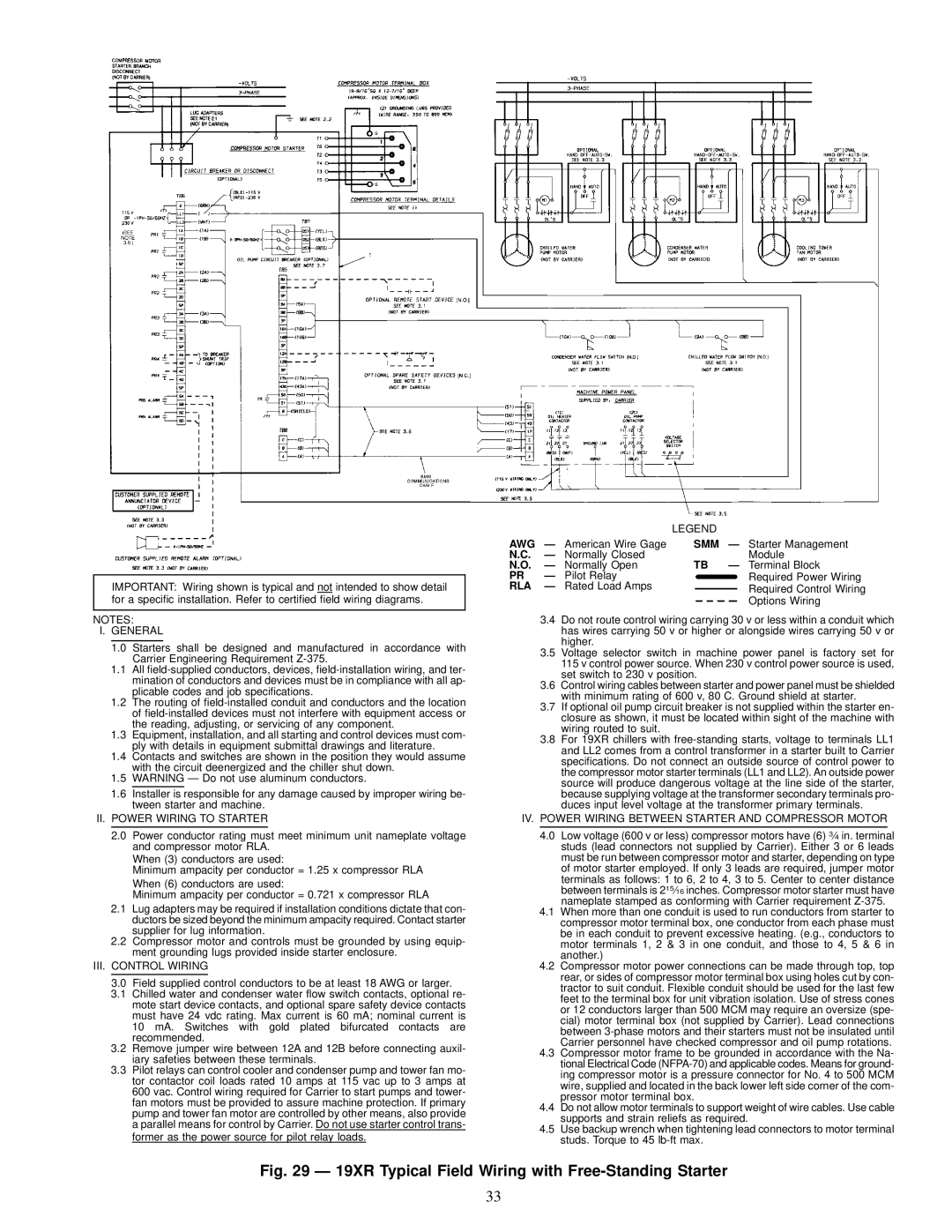IMPORTANT: Wiring shown is typical and not intended to show detail for a speci®c installation. Refer to certi®ed ®eld wiring diagrams.
NOTES:
I.GENERAL
1.0Starters shall be designed and manufactured in accordance with Carrier Engineering Requirement Z-375.
1.1All ®eld-supplied conductors, devices, ®eld-installation wiring, and ter- mination of conductors and devices must be in compliance with all ap- plicable codes and job speci®cations.
1.2The routing of ®eld-installed conduit and conductors and the location of ®eld-installed devices must not interfere with equipment access or the reading, adjusting, or servicing of any component.
1.3Equipment, installation, and all starting and control devices must com- ply with details in equipment submittal drawings and literature.
1.4Contacts and switches are shown in the position they would assume with the circuit deenergized and the chiller shut down.
1.5WARNING Ð Do not use aluminum conductors.
1.6Installer is responsible for any damage caused by improper wiring be- tween starter and machine.
II.POWER WIRING TO STARTER
2.0Power conductor rating must meet minimum unit nameplate voltage and compressor motor RLA.
When (3) conductors are used:
Minimum ampacity per conductor = 1.25 x compressor RLA
When (6) conductors are used:
Minimum ampacity per conductor = 0.721 x compressor RLA
2.1Lug adapters may be required if installation conditions dictate that con- ductors be sized beyond the minimum ampacity required. Contact starter supplier for lug information.
2.2Compressor motor and controls must be grounded by using equip- ment grounding lugs provided inside starter enclosure.
III.CONTROL WIRING
3.0Field supplied control conductors to be at least 18 AWG or larger.
3.1Chilled water and condenser water ¯ow switch contacts, optional re- mote start device contacts, and optional spare safety device contacts must have 24 vdc rating. Max current is 60 mA; nominal current is 10 mA. Switches with gold plated bifurcated contacts are recommended.
3.2Remove jumper wire between 12A and 12B before connecting auxil- iary safeties between these terminals.
3.3Pilot relays can control cooler and condenser pump and tower fan mo- tor contactor coil loads rated 10 amps at 115 vac up to 3 amps at 600 vac. Control wiring required for Carrier to start pumps and tower- fan motors must be provided to assure machine protection. If primary pump and tower fan motor are controlled by other means, also provide a parallel means for control by Carrier. Do not use starter control trans- former as the power source for pilot relay loads.
| | | LEGEND |
AWG | Ð American Wire Gage | SMM Ð Starter Management |
N.C. | Ð | Normally Closed | Module |
N.O. | Ð | Normally Open | TB Ð Terminal Block |
PR | Ð Pilot Relay | Required Power Wiring |
RLA | Ð | Rated Load Amps | Required Control Wiring |
Options Wiring
3.4Do not route control wiring carrying 30 v or less within a conduit which has wires carrying 50 v or higher or alongside wires carrying 50 v or higher.
3.5Voltage selector switch in machine power panel is factory set for 115 v control power source. When 230 v control power source is used, set switch to 230 v position.
3.6Control wiring cables between starter and power panel must be shielded with minimum rating of 600 v, 80 C. Ground shield at starter.
3.7If optional oil pump circuit breaker is not supplied within the starter en- closure as shown, it must be located within sight of the machine with wiring routed to suit.
3.8For 19XR chillers with free-standing starts, voltage to terminals LL1 and LL2 comes from a control transformer in a starter built to Carrier speci®cations. Do not connect an outside source of control power to the compressor motor starter terminals (LL1 and LL2). An outside power source will produce dangerous voltage at the line side of the starter, because supplying voltage at the transformer secondary terminals pro- duces input level voltage at the transformer primary terminals.
IV. POWER WIRING BETWEEN STARTER AND COMPRESSOR MOTOR
4.0Low voltage (600 v or less) compressor motors have (6) 3¤4 in. terminal studs (lead connectors not supplied by Carrier). Either 3 or 6 leads must be run between compressor motor and starter, depending on type of motor starter employed. If only 3 leads are required, jumper motor terminals as follows: 1 to 6, 2 to 4, 3 to 5. Center to center distance between terminals is 215¤16 inches. Compressor motor starter must have nameplate stamped as conforming with Carrier requirement Z-375.
4.1When more than one conduit is used to run conductors from starter to compressor motor terminal box, one conductor from each phase must be in each conduit to prevent excessive heating. (e.g., conductors to motor terminals 1, 2 & 3 in one conduit, and those to 4, 5 & 6 in another.)
4.2Compressor motor power connections can be made through top, top rear, or sides of compressor motor terminal box using holes cut by con- tractor to suit conduit. Flexible conduit should be used for the last few feet to the terminal box for unit vibration isolation. Use of stress cones or 12 conductors larger than 500 MCM may require an oversize (spe- cial) motor terminal box (not supplied by Carrier). Lead connections between 3-phase motors and their starters must not be insulated until Carrier personnel have checked compressor and oil pump rotations.
4.3Compressor motor frame to be grounded in accordance with the Na- tional Electrical Code (NFPA-70) and applicable codes. Means for ground- ing compressor motor is a pressure connector for No. 4 to 500 MCM wire, supplied and located in the back lower left side corner of the com- pressor motor terminal box.
4.4Do not allow motor terminals to support weight of wire cables. Use cable supports and strain reliefs as required.
4.5Use backup wrench when tightening lead connectors to motor terminal studs. Torque to 45 lb-ft max.

